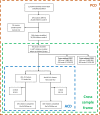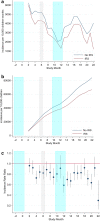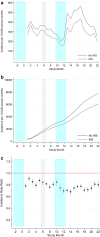Incremental impact on malaria incidence following indoor residual spraying in a highly endemic area with high standard ITN access in Mozambique: results from a cluster-randomized study
- PMID: 33568137
- PMCID: PMC7877039
- DOI: 10.1186/s12936-021-03611-7
Incremental impact on malaria incidence following indoor residual spraying in a highly endemic area with high standard ITN access in Mozambique: results from a cluster-randomized study
Abstract
Background: Attaining the goal of reducing the global malaria burden is threatened by recent setbacks in maintaining the effectiveness of vector control interventions partly due to the emergence of pyrethroid resistant vectors. One potential strategy to address these setbacks could be combining indoor residual spraying (IRS) with non-pyrethroids and standard insecticide-treated nets (ITNs). This study aimed to provide evidence on the incremental epidemiological benefit of using third-generation IRS product in a highly endemic area with high ITN ownership.
Methods: A cluster-randomized, open-label, parallel-arms, superiority trial was conducted in the Mopeia district in Zambezia, Mozambique from 2016 to 2018. The district had received mass distribution of alphacypermethrin ITNs two years before the trial and again mid-way. 86 clusters were defined, stratified and randomized to receive or not receive IRS with pirimiphos-methyl (Actellic®300 CS). Efficacy of adding IRS was assessed through malaria incidence in a cohort of children under five followed prospectively for two years, enhanced passive surveillance at health facilities and by community health workers, and yearly cross-sectional surveys at the peak of the transmission season.
Findings: A total of 1536 children were enrolled in the cohort. Children in the IRS arm experienced 4,801 cases (incidence rate of 3,532 per 10,000 children-month at risk) versus 5,758 cases in the no-IRS arm (incidence rate of 4,297 per 10,000 children-month at risk), resulting in a crude risk reduction of 18% and an incidence risk ratio of 0.82 (95% CI 0.79-0.86, p-value < 0.001). Facility and community passive surveillance showed a malaria incidence of 278 per 10,000 person-month in the IRS group (43,974 cases over 22 months) versus 358 (95% CI 355-360) per 10,000 person-month at risk in the no-IRS group (58,030 cases over 22 months), resulting in an incidence rate ratio of 0.65 (95% CI 0.60-0.71, p < 0.001). In the 2018 survey, prevalence in children under five in the IRS arm was significantly lower than in the no-IRS arm (OR 0.54, 95% CI, 0.31-0.92, p = 0.0241).
Conclusion: In a highly endemic area with high ITN access and emerging pyrethroid resistance, adding IRS with pirimiphos-methyl resulted in significant additional protection for children under five years of age.
Trial registration: ClinicalTrials.gov identifier NCT02910934, registered 22 September 2016, https://clinicaltrials.gov/ct2/show/NCT02910934?term=NCT02910934&draw=2&rank=1 .
Keywords: Indoor residual spraying; Insecticide resistance; Insecticide‐treated nets; Mozambique; Vector control.
Conflict of interest statement
The authors declare that they have no competing interests.
Figures




Similar articles
-
Cost and cost-effectiveness of indoor residual spraying with pirimiphos-methyl in a high malaria transmission district of Mozambique with high access to standard insecticide-treated nets.Malar J. 2021 Mar 10;20(1):143. doi: 10.1186/s12936-021-03687-1. Malar J. 2021. PMID: 33691706 Free PMC article.
-
Reduced exposure to malaria vectors following indoor residual spraying of pirimiphos-methyl in a high-burden district of rural Mozambique with high ownership of long-lasting insecticidal nets: entomological surveillance results from a cluster-randomized trial.Malar J. 2021 Jan 21;20(1):54. doi: 10.1186/s12936-021-03583-8. Malar J. 2021. PMID: 33478533 Free PMC article. Clinical Trial.
-
Indoor residual spraying for preventing malaria in communities using insecticide-treated nets.Cochrane Database Syst Rev. 2019 May 23;5(5):CD012688. doi: 10.1002/14651858.CD012688.pub2. Cochrane Database Syst Rev. 2019. Update in: Cochrane Database Syst Rev. 2022 Jan 17;1:CD012688. doi: 10.1002/14651858.CD012688.pub3. PMID: 31120132 Free PMC article. Updated.
-
Combining next-generation indoor residual spraying and drug-based malaria control strategies: observational evidence of a combined effect in Mali.Malar J. 2020 Aug 15;19(1):293. doi: 10.1186/s12936-020-03361-y. Malar J. 2020. PMID: 32799873 Free PMC article.
-
Insecticide-treated nets for preventing malaria.Cochrane Database Syst Rev. 2018 Nov 6;11(11):CD000363. doi: 10.1002/14651858.CD000363.pub3. Cochrane Database Syst Rev. 2018. PMID: 30398672 Free PMC article.
Cited by
-
Burden and risk factors of snakebite in Mopeia, Mozambique: Leveraging larger malaria trials to generate data of this neglected tropical disease.PLoS Negl Trop Dis. 2023 Aug 17;17(8):e0011551. doi: 10.1371/journal.pntd.0011551. eCollection 2023 Aug. PLoS Negl Trop Dis. 2023. PMID: 37590272 Free PMC article.
-
Six decades of malaria vector control in southern Africa: a review of the entomological evidence-base.Malar J. 2022 Oct 2;21(1):279. doi: 10.1186/s12936-022-04292-6. Malar J. 2022. PMID: 36184603 Free PMC article. Review.
-
Impact of Late-Rainy Season Indoor Residual Spraying on Holoendemic Malaria Transmission: A Cohort Study in Northern Zambia.J Infect Dis. 2025 Apr 15;231(4):1020-1030. doi: 10.1093/infdis/jiae609. J Infect Dis. 2025. PMID: 39699125
-
Training of Field-Workers for Rapid Assessment of Scabies Prevalence: A Diagnostic Accuracy Study in Mozambique.Am J Trop Med Hyg. 2024 Sep 18;111(6):1320-1325. doi: 10.4269/ajtmh.24-0204. Print 2024 Dec 4. Am J Trop Med Hyg. 2024. PMID: 39293407 Free PMC article.
-
Inferring the epidemiological benefit of indoor vector control interventions against malaria from mosquito data.Nat Commun. 2022 Jul 5;13(1):3862. doi: 10.1038/s41467-022-30700-1. Nat Commun. 2022. PMID: 35790746 Free PMC article.
References
-
- WHO-RBM. Action and Investment to defeat Malaria 2016–2030. For a Malaria-Free World. https://www.rollbackmalariaorg/about/about-rbm/aim-2016-2030. 2015.
-
- WHO. World Malaria Report 2018. Geneva, World Health Organization, 2018. https://www.hoint/malaria/publications/world-malaria-report-2018/en/.
-
- WHO. Global technical strategy for malaria 2016–2030. Geneva, World Health Organization. Available at http://www.who.int/malaria/areas/global_technical_strategy/en/ (Accessed 27 September 2018).
MeSH terms
Substances
Associated data
LinkOut - more resources
Full Text Sources
Other Literature Sources
Medical

